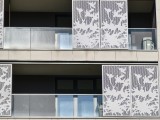vivo X100 Pro review

Trio of 50MP cameras, one of them a unique 100mm periscope
The X100 Pro is equipped with a camera system like no other, its uniqueness stemming from at least one component - the 100mm periscope telephoto with a large sensor and floating lens that can focus far and near alike. The 1-inch main camera is also most welcome, don't get us wrong, as is the autofocusing ultrawide unit, all three of them having 50MP sensors.

The main camera is based on the Sony IMX 989. It's got 1.6µm pixels and a Quad Bayer filter array and outputs 12.5MP images after 4-to-1 binning. In front of it, there's a stabilized lens with a 23mm equivalent focal length and an f/1.8 aperture (vivo insists on calling it f/1.75).
The ultrawide camera has a 15mm equivalent lens with an f/2.0 aperture and autofocus capability. Its sensor is the Samsung JN1 with a 1/2.76" optical format and 0.64µm pixel pitch.
We'd say the star of the show is the telephoto camera, though. The official specs list a 50MP sensor with a 1/2.0" optical format, but the fine print details that an imaging area equivalent to that of a 1/2.51" sensor is being used. That bodes well with hardware apps reporting the OmniVision OV64B sensor - a 64MP 1/2.0" unit with 0.7µm pixels of which the vivo is apparently using the center 50MP portion for its telephoto purposes. That's in fact the sensor used on the Find N3 and the iQOO 12 for their telephotos.
Here, it's mated to a periscope that features floating elements, a design which enables focusing at just 18cm from the subject as well as 4.5-stop CIPA-rated optical stabilization capability.
Over on the front of the X100 Pro, there's a 32MP selfie camera paired with a 20mm-equivalent lens with an f/2.0 aperture and fixed focus.
Camera app and features
The camera app on the X100 Pro is similar to the ones we've gotten from previous vivos. There's a straightforward zoom selector that gives you direct access to each of the three cameras plus their hybrid zoom levels (2x, 10x).

The main modes are arranged in a carousel formation, and you can switch between them by swiping or tapping on one of the visible modes. Accessing the Super Macro mode is done from the flower icon next to the settings cog wheel, but there's an auto-on option, too, that kicks in when you get very close to a subject (albeit with limited functionality compared to the Super macro mode). The More tab lists the rest of the modes, and from there, you can also customize the modes you have available in the viewfinder.
The Pro mode gives you all the freedom to adjust the autofocus, white balance, shutter speed, ISO and exposure compensation, and you can do so on all three cameras. There's helpful information explaining all of the options above if you are just getting into photography. Shooting in RAW format is also an option.
Daylight photo quality
The X100 Pro captures superb photos with its main camera in broad daylight - anything other than that would be unacceptable for a premium smartphone these days. Dynamic range is excellent and you can count on well developed shadows and good highlight preservation. Colors are vibrant outdoors but somewhat muted in our in-office scenes, with white balance being consistently accurate.
Noise is non-existent and detail is abundant in these 12.5MP images, plus it's rendered in a likeable organic fashion. When it's in focus, that is - the large sensor/bright lens combo make for a pretty shallow depth of field. That can be a desired effect, but can also mean not being able to get all of your subject in sharp focus. We're mostly in camp 'shallower DoF is better', so we're liking the results, particularly evident with nearby subjects.















Daylight samples, main camera (1x)
The full-res photos do contain a smidge more detail, but it's hardly reason enough to shoot that way.








Daylight samples, main camera (1x), 50MP
The 2x zoom level makes substantially better use of those 50MP and we get excellent 46-mm-equivalent photos - as good as any dedicated 2x camera on a smartphone, possibly better, really. Pixel-level detail is remarkably good - those balcony blinds, the fine tree twigs, the strands of grass, you name it. There's no uptick in noise either and the global parameters remain on par with the 1x images. Truly great stuff.











Daylight samples, main camera (2x)
Zooming in to 4.3x (or 100mm equivalent), things remain stellar. The telephoto captures nicely detailed images with a natural look to fine textures and contrasty edges. Noise is again nowhere to be seen. Dynamic range is excellent, colors are lively without being over the top.








Daylight samples, telephoto camera (4.3x)
The full-res mode on the telephoto is of debatable usefulness. We wouldn't say there's extra detail to be seen, but on the other hand noise does become more visible here and dynamic range takes a bit of a hit .








Daylight samples, telephoto camera (4.3x), 50MP
Once again, zooming in further while keeping the resolution at 12.5MP makes for more detailed shots with superior sharpness and definition. We would have almost dismissed the 10x button in the zoom selector as too much of a stretch for the 4.3x telephoto, but in fact the 233mm equivalent shots are very good.







Daylight samples, telephoto camera (10x)
Taking a sharp turn to have a look at the opposite end of the zoom range, our feelings are a bit mixed. Our main gripe is that its coverage is only moderately ultra wide. Coupled with the relatively wide primary camera, that makes for not all that much of a separation between the two focal lengths.
Other than that, we're happy with the results. Detail is good, noise performance is solid. Dynamic range is nicely wide and the color rendition is great too.















Daylight samples, ultrawide camera (0.6x)
Stop us if you've heard this before, but the full-res mode on the X100 Pro's ultrawide is largely pointless.








Daylight samples, ultrawide camera (0.6x), 50MP
Low-light photo quality
In low-light, the X100 Pro has an auto Night mode feature - what has become essentially a standard implementation. A crescent icon lights up in yellow in the corner of the viewfinder to inform you it's doing its thing - vivo calls it 'Dim light' - and you can press that icon to disable it, if you so wish. In our experience, the auto was active most of the time and most of the time produced identical results to those we got in the dedicated Night mode. Additionally, turning off the Dim light switch often made little difference, though in some cases there were notable changes.
Main camera
The main camera captures great low-light photos. Dynamic range is excellent and you can count on well developed tonal extremes and well judged exposures. The auto white balance handles mixed lighting with no issue and colors maintain the vibrant rendition we saw during the day. Detail is mostly great, though there's a hint of aggressive sharpening in some scenes and types of textures - not too bad, but it's there.








Low-light samples, main camera (1x), auto Night mode (Dim light)
Here's how these same scenes look in the dedicated Night mode - we'd say they're the same.








Low-light samples, main camera (1x), Night mode
There's not a world of difference if you disable Dim light either. If you look long and hard, perhaps you may notice a small difference in sharpening in this scene or that, or maybe a slightly brighter highlight area here or there. Rarely does it make a meaningful impact on the image as a whole, but the eighth scene does look worse in terms of exposure when Photo mode is left to its own devices.








Low-light samples, main camera (1x), no Night mode
At 2x zoom level photos remain remarkably high-quality even at night. Once more, the full auto Dim light results are the same as those in Night mode.






Low-light samples, main camera (2x), auto Night mode (Dim light)






Low-light samples, main camera (2x), no Night mode
With no Night mode, there can be the occasional darker shadow area, but it's only slightly so and it's more of a rare occurrence than it is the norm.






Low-light samples, main camera (2x), Night mode
Telephoto camera
The periscope telephoto exhibits ever so slightly different behavioral patterns, including some variation between Photo and Night mode and a more consistent tendency for darker exposures with Dim light turned off.
Both Photo mode with Dim light on and Night mode capture balanced exposures with controlled highlight clipping and good development in the dark areas - there's little to split the two modes in this respect. We did get slight variations in white balance between the two modes more often than usual, with Photo mode leaning a little greener (fourth and seventh scene).
The amount of captured detail is very good and it's looking better and more natural in Photo mode than the more heavily processed Night mode rendition. Weirdly enough, disabling Dim light in Photo mode also results in that more aggressive sharpening that's absent in the Photo/Dim light on shots.
Quite apparent is this lens' astigmatism which creates nice sunstar-like Christmas tree lights, but is otherwise annoying in most other settings.








Low-light samples, telephoto camera (4.3x), auto Night mode (Dim light)








Low-light samples, telephoto camera (4.3x), Night mode








Low-light samples, telephoto camera (4.3x), no Night mode
There doesn't appear to be an auto Night mode for the 10x zoom level, and Photo mode remains crescent-less, regardless of ambient light levels. The images are quite similar-looking, though the Night mode ones do have a minor edge in noise reduction and sharpness in the shadows. Overall, pretty solid 10x shots.






Low-light samples, telephoto camera (10x), Photo mode






Low-light samples, telephoto camera (10x), Night mode
Ultrawide camera
The ultrawide brings the crescent back and it does what it did on the other cameras. We're getting well exposed shots with nicely developed shadows and good highlight preservation. Colors don't suffer from any desaturation in the dark and we didn't encounter white balance issues. We'd say there's no difference between the full auto and the dedicated Night mode, but if you spot any, we'd attribute it to shot-to-shot variation rather than mode specifics.








Low-light samples, ultrawide camera (0.6x), auto Night mode (Dim light)








Low-light samples, ultrawide camera (0.6x), Night mode
Turning off the Dim light toggle in Photo mode will result in darker, softer, and noisier shadows with a high degree of consistency. Little else will change.








Low-light samples, ultrawide camera (0.6x), no Night mode
Once you're done with the real world samples, head over to our Photo compare tool to see how the vivo X100 Pro stacks up against the competition.


vivo X100 Pro against the Xiaomi 13 Ultra and the Pixel 8 Pro in our Photo compare tool
Reader comments
- Chunmaru
- 22 Oct 2024
- t7W
Can't find any compatible game trigger/controller just because of the camera bump at the back 😔
- Legend007
- 08 Sep 2024
- X@B
I still use it and really liking this device, I used s23U prior to this. - Build quality is better than galay ultra series and I feel its solid whenever hold in hand - Camera is obviously better mainly in portraits - bugs - never saw even s...
- Legend007
- 08 Sep 2024
- X@B
I still use it and really liking this device, I used s23U prior to this. - Build quality is better than galay ultra series and I feel its solid whenever hold in hand - Camera is obviously better mainly in portraits - bugs - never saw even s...





